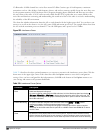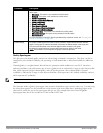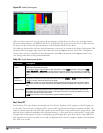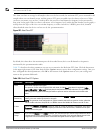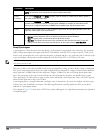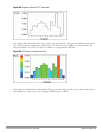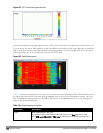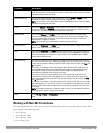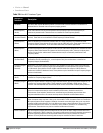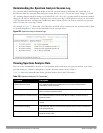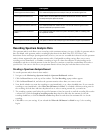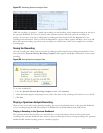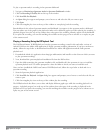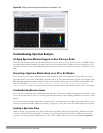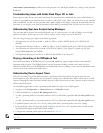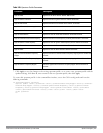
607 | Spectrum Analysis DellPowerConnectW-SeriesArubaOS6.2 | User Guide
l Device vs Channel
l Interference Power
Non-Wi-Fi
Interferer
Description
Bluetooth Any device that uses the Bluetooth protocol to communicate in the 2.4 GHz band is classified as a
Bluetooth
device. Bluetooth uses a frequency hopping protocol.
Fixed Frequency
(Audio)
Some audio devices such as wireless speakers and microphones also use fixed frequency to
continuously transmit audio. These devices are classified as
Fixed Frequency (Audio)
.
Fixed Frequency
(Cordless Phones)
Some cordless phones use a fixed frequency to transmit data (much like the fixed frequency video
devices). These devices are classified as
Fixed Frequency (Cordless Phones)
.
Fixed Frequency
(Video)
Video transmitters that continuously transmit video on a single frequency are classified as
Fixed
Frequency (Video
). These devices typically have close to a 100% duty cycle. These types of devices may
be used for video surveillance, TV or other video distribution, and similar applications.
Fixed Frequency
(Other)
All other fixed frequency devices that do not fall into one of the above categories are classified as
Fixed
Frequency (Other
). Note that the RF signatures of the fixed frequency audio, video and cordless phone
devices are very similar and that some of these devices may be occasionally classified as Fixed
Frequency (Other).
Frequency Hopper
(Cordless Base)
Frequency hopping cordless phone base units transmit periodic beacon-like frames at all times. When
the handsets are not transmitting (i.e., no active phone calls), the cordless base is classified as
Frequency Hopper (Cordless Base
).
Frequency Hopper
(Cordless
Network)
When there is an active phone call and one or more handsets are part of the phone conversation, the
device is classified as
Frequency Hopper (Cordless Network
). Cordless phones may operate in 2.4 GHz
or 5 GHz bands. Some phones use both 2.4 GHz and 5 GHz bands (for example, 5 GHz for Base-to-
handset and 2.4 GHz for Handset-to-base). These phones may be classified as unique Frequency Hopper
devices on both bands.
Frequency Hopper
(Xbox)
The Microsoft Xbox device uses a frequency hopping protocol in the 2.4 GHz band. These devices are
classified as
Frequency Hopper (Xbox
).
Frequency Hopper
(Other)
When the classifier detects a frequency hopper that does not fall into one of the above categories, it is
classified as Frequency Hopper (Other). Some examples include IEEE 802.11 FHSS devices, game
consoles and cordless/hands-free devices that do not use one of the known cordless phone protocols.
Microwave Common residential microwave ovens with a single magnetron are classified as a
Microwave
. These
types of microwave ovens may be used in cafeterias, break rooms, dormitories and similar
environments. Some industrial, healthcare or manufacturing environments may also have other
equipment that behave like a microwave and may also be classified as a Microwave device.
Microwave
(Inverter)
Some newer-model microwave ovens have the inverter technology to control the power output and
these microwave ovens may have a duty cycle close to 100%. These microwave ovens are classified as
Microwave (Inverter)
. Dual-magnetron industrial microwave ovens with higher duty cycle may also be
classified as Microwave (Inverter). As in the Microwave category described above, there may be other
equipment that behave like inverter microwaves in some industrial, healthcare or manufacturing
environments. Those devices may also be classified as Microwave (Inverter).
Generic Interferer Any non-frequency hopping device that does not fall into one of the other categories described in this
table is classified as a
Generic Interferer
. For example a Microwave-like device that does not operate in
the known operating frequencies used by the Microwave ovens may be classified as a Generic
Interferer. Similarly wide-band interfering devices may be classified as Generic Interferers.
Table 234:
Non-Wi-Fi Interferer Types



